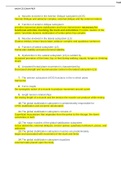heal
NASM CES EXAM PREP
1. Muscles involved in the Anterior Oblique subsystem (AOS)
Internal Oblique and adductor complex, external oblique and hip external rotators
2. Function of anterior oblique subsystem
provides transverse plane stabilization and force transmission necessary for
functional activities involving the trunk and extremities Provides rotation of the
pelvis *provides dynamic stabilization of lumbo-pelvic-hip complex
3. Muscles involved in the lateral subsystem (LS)
Gluteus medius, tensor fascia latae, adducor complex and quadratus lumborum
4. Function of lateral subsystem (LS)
frontal plan stability and pelvo-femoral stability,
5. Dysfunction in the Lateral subsystem (LS) is evident by
increased pronation of the knee, hip, or feet during walking, squats, lunges or climbing
chairs
6. Unwanted frontal plane movement is characterized by
Decreased strength and neuromuscular control in the lateral subsystem (LS)
7. The anterior subsystem (AOS) functions in the in which plane
transverse
8. Force couple
the synergistic action of a muscle to produce movement around a joint
9. length tension relationships
the resting length of a muscle and the tension the muscle can produce while resting
10. The global stabilization subsystem in predominantly responsible for
LPHC stabilization and eccentric deceleration
11. The global stabilization subsystem consists of
Superficial musculature that originates from the pelvis to the ribcage, the lower
extremities or both
12. The major muscles of the global stabilization subsystem
rectus abdominis, external obliques, erector spinae, quadratus lumborum, psoas, and
adductors
13. The global stabilization subsystem muscles are predominately
larger and associated with movement of the trunk and limbs
14. The global stabilization subsystem equalizes
external loads placed upon the body
,NASM CES EXAM PREP
15. The muscles of the global stabilization subsystem are important in
transferring and absorbing forces from the upper and lower extremities to the pelvis
(eccentric deceleration)
16. The global movement system is predominately responsible for
concentric force production (acceleration)
17. The muscles that make up global movement system
gastrocnemius, hamstrings, quadriceps, gluteus maximus, latissimus dorsi and
pectoralis major
18. The local muscular system or local stabilization system consists of muscles that
are primarily involved in
joint support or stabilization
19. The local muscular system or local stabilization system joint support muscles are
not
movement specific
20. The local muscular system or local stabilization system joint support muscles
provide
stability to allow joint movement
21. Overhead squat anterior view, feet turn out probable overactive muscles
soleus, lat. gastrocnemius, biceps femoris, tensor fascia late
22. Overhead squat anterior view, feet turn out probable under active muscles
med gastrocnemius, med hamstring, gluteus medius/maximus, gracilis, sartorius,
popliteus
23. Overhead squat anterior view, feet move inward probable overactive muscles
adductor complex, biceps femoris, TFL, lat gastrocnemius, vastus lateralis
24. Overhead squat anterior view, feet move inward probable underactive muscles
med hamstring, med gastrocnemius, gluteus medius/maximus, vastas medialis
25. Overhead squat anterior view, feet move outward probable overactive muscles
piriformis, bicep femoris, TFL, gluteus medius/maximus
26. Overhead squat anterior view, feet move outward probable under active muscles
adductor complex, med hamstring, gluteus maximus
27. overhead squat assessment lateral view, LPHC, excessive forward lean probable
overactive muscles
soleus, gastrocnemius, hip flexor complex, abdominal complex
,NASM CES EXAM PREP
28. overhead squat assessment lateral view, LPHC, excessive forward lean probable
under active muscles
anterior tibialis, gluteus maximus, erector spinae
29. overhead squat assessment lateral view, LPHC, low back arches probable
overactive muscles
hip flexor complex, erector spinae, latissimus dorsi
30. overhead squat assessment lateral view, LPHC, low back arches probable under
active muscles
gluteus maximus, erector spinae, latissimus dorsi, psoas, intrinsic core, stabilzers
31. overhead squat assessment lateral view, LPHC, arms fall forward probable
overactive muscles
latissimus dorsi, pectoralis major/minor, teres major, corcobrachialis
32. overhead squat assessment lateral view, upper body, arms fall forward probable
under active muscles
mid/lower trapezius, rhomboids, rotator cuff, posterior deltoid
33. overhead squat assessment posterior view, feet flatten probable over active
muscles
peroneal complex (peroneus tertius, peroneus brevis, peroneus longus) biceps femoris,
TFL, lat gastrocnemius
34. overhead squat assessment posterior view, feet flatten probable under active
muscles
posterior tibialis, anterior tibialis, med gastrocnemius, gluteus medius, med hamstring
35. overhead squat assessment posterior view, heels rise probable under active
muscles
anterior tibialis
36. over head squat assessment posterior view, asymmetrical weight shift probable
under active muscles
gluteus medius (on one side) adductor complex (opposite side of shift)
37. over head squat assessment posterior view, asymmetrical weight shift probable
over active muscles
adductor complex, TFL, piriformis, bicep femois (short head) gluteus medius (opposite
of shift)
38. sensorimotor intergration
ability of the central nervous system to gather and interpret sensory information to
execute the proper motor response
motor learning
, NASM CES EXAM PREP
the integration of these motor control processes through practice and experience,
leading to a relatively permanent chance in the capacity to produce skilled movements
39. scapular stabilizers during squats
trapezius, rhomoids, cervical stabilizers
40. lumbo hip complex stabilizers during squats
adductor longus, adductor brevis, transverse abdominus, gluteus medius
41. lower extreme stabilizers during squats
flexor hallicus longus, poeterior tibialis, anterior tibialis, soleus, gastrocnemius
42. prime movers during squats
quadiceps, gluteus maximus
43. synergist during squats
hamstring, adductor magnus, gastronemius, soleus complex, posterior tibialis
44. stabilizers during bench press
rotator cuff, biceps
45. synergists during bench press
anterior deltoid, triceps
46. prime movers during bench press
pectoralis major
47one form of sensory afferent information that uses mechanoreptors from cutaneous
muscle, tendon, and joint receptors to provide information about static and dynamic
positions, movements, and sensations related to muscle force and movement
Proprioception
47. the cumulative neural input from sensory afferents to the central nervous system
Lephart definition of proprioception
48. common static malalignments
poor posture, joint hypomobility, myofascial adhesions.
49. one of the most common cause of pain
joint dysfunction (hypomobility)
50. compensations for the anterior view of the single leg squat, feet flatten probable
over active muscles
soleus, lat gastrocnemius, bicpes femoris, TFL




